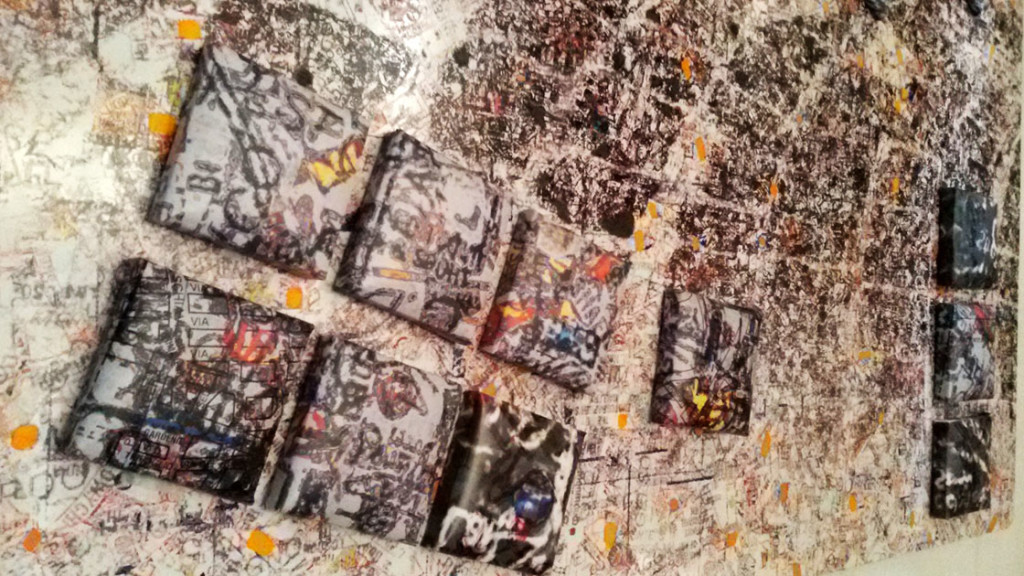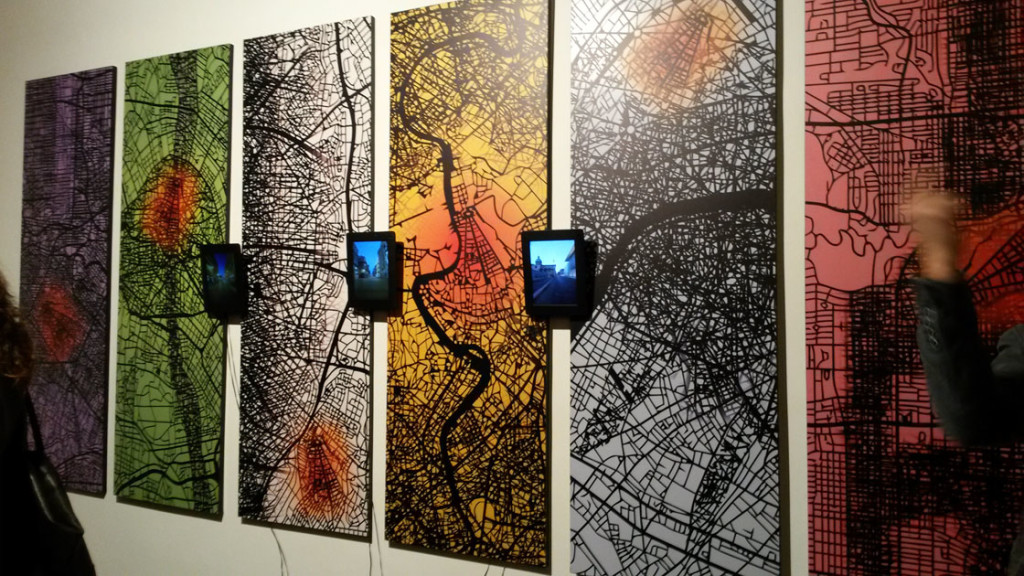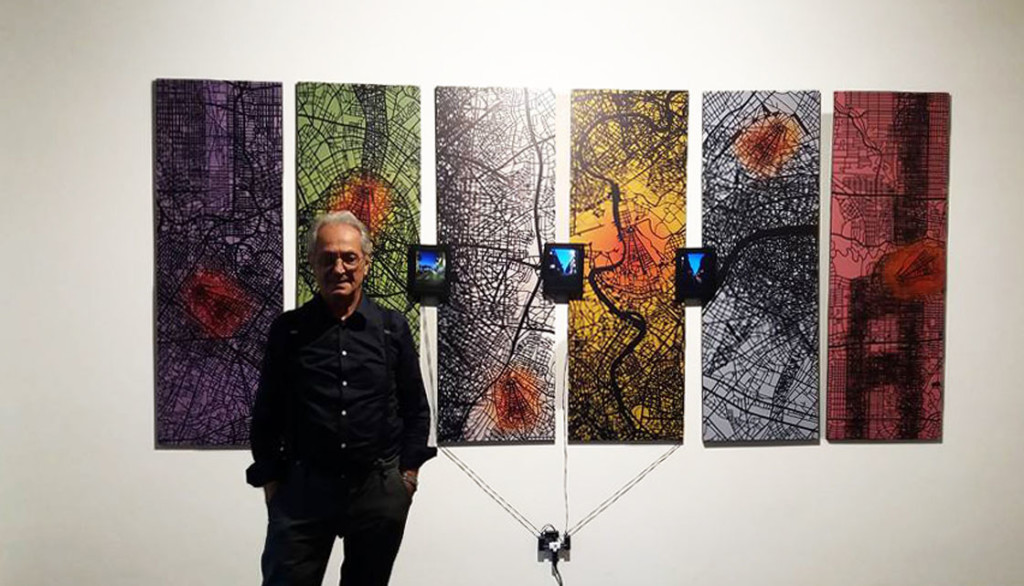
Since the very beginning of his career, the work of Mario Sasso (b. 1934, Staffolo) revolves around a theme that has flowed through every stage of his artistic quest, including his most recent work, presented at the offices of the Associazione Operatori Culturali Flaminia 58. The theme at hand is the city and the exhibit, curated by Francesca Gallo, was christened Tridente because it was born amongst works paying tribute to the Piazza del Popolo and the three streets branching out from the square that lead to the centre of Rome.
The painter and video artist was a pioneer in Italy in the development of computer graphics and experimented with the way old and new media ‘meet’, creating an exchange between the materiality and static quality of painting and the dynamism and immateriality of the electronic image. Tridente – Opere dal 2012 al 2015 displays the results of research that lasted a decade and led Sasso to the redefinition and remodelling of painting (the very starting point of his artistic quest) with the help of new media forms.

He arrived in Rome in 1958 and combined his painting with his work for RAITV, developing a great number of theme songs that made Italian television history. He took on traditional animation techniques at first and with the arrival of tools such as Paintbox (the first computer designed for electronic painting) in the 1980s; he incorporated computer development into his work.
As far back as the 1960s, the subject of his paintings was urban areas but by the middle of the following decade these areas were represented with roller shutters, mailboxes, public phones and the typical Roman sampietrini pavement – painted with a wealth of colour that gives the work a Hyperrealism quality. Sampietrini pavement is back, reinserted in some of the works displayed at the Tridente exhibit, only in a completely renovated form: the image of the sett was developed on a computer and later printed while the lack of the painted layer was replaced by a tri-dimensional materialization of this pavement that everts. Some even make up barely legible words such as ROMA, San PIETRINI and PIETRE DI CITTA’.

A closer look reveals that the chaotic interweaving of lines and colours conceal an underlying image, the departure point for a development of computer graphics: the street guide – introduced by Sasso in the late 80s as an arrival point of a line of vision that becomes increasingly distant and aerial. If reading the map was hindered by gestural and material painting in the 1990s, this is no longer the case now: procedures and supports have changed to limit the use of painting, or at least the use of painting in the traditional sense. There is still painting in these works, only it has become electronic and characterized by the same possibility of doing touch-up after touch-up and from the same stratification of real painting. The difference is that it doesn’t produce concrete width and the artist’s hand doesn’t work directly on the support. In fact, even support is altered – traditional materials are replaced by contemporary ones such as PVC. An example of this is on display: Territorio digitale (2015) is a large “painting” but when examined close up, we see that that it is a computer keyboard – only the keys are identical to the sampietrini pavement used in the works exhibited on the walls. Territorio digitale is an ambiguous object that contains several concepts in that it makes us ponder the computerization of technology and reminds us of the all-but-forgotten “typeballs” of the IBM Selectric typewriter, once the inspiration of Sasso’s famous Tg3 theme (1986).

Thin PVC helps overcome the rigid edges of the painting. Once freed from its framework, it can take on new forms – as seen in one of the works that gives the exhibit its title. This Trident is made up of many rectangular bricks. The unifying image leaves its place to the construction to fragmentation, according to a line of thinking that acted as protagonist at the Còllant exhibit at the Maria Coccia Gallery (2012) in which the Dove si incrociano le città (Where cities are interweaved) installation was made up of many fragments of PVC that replicated the marble stones in the Forma Urbis Romae created under the Emperor Septemius Severus, just one of countless street guides. The exception here is that the Forma Urbis is most definitely archaic.
That particular exhibit displayed ten videos (now on view at the artist’s studio) that replicate the walks taken at dawn along different streets in Rome according to a method also seen in Città Verticali (Vertical Cities – 2015). The work is made up of three videos showing three streets (via del Babuino, via del Corso and via di Ripetta) and six aluminium panels of the maps of another three cities – each of which a Trident emerges as their pulsing heart. In the words of Francesca Gallo: “…the title suggests the vertical nature of the view which gives origin to the cartography that creates an exchange with the viewpoint so typical of the erect station, represented by three videos – a metaphor of the exploration of an area”. This time the map is not modified in order to hinder its reading. To the contrary, it was the artist’s intention to use clear-cut lines to conjure up the ancient technique of xylography – yet another reference to graphic-pictorial tradition. Sasso has been exploring the comparison between static and dynamic images since the days of his On/Off exhibit (1989) in which he presented his Pictogrammi – Videogrammi, canvases that contained LCD screens to dynamize the painting while opening it onto another space, taking the lessons of Spatialism to extremes.
The Tridente exhibit offers an opportunity to compare technological tools on the shared basis of a walk along the streets of Rome. The suspended atmosphere of Città Verticali is also visible in a video later used as the final closing credits of the television programme La Notte della Repubblica (1989), displayed for this specific occasion at AOCF58 and the exhibit’s only reference to Sasso’s work at the RAI. A walk at night that the artist explains as communicating a floating effect thanks to the use of the steady cam, an effect that is quite different from the movements produced when walking with a more manageable videocam – as is the case for the three videos of Città Verticali where each step can be felt. The connecting link is found in his Telecamera su Roma (1999) which has been exhibited many times but not until now has it been displayed in the city it is dedicated to. This video is of another walk where a handycam filmed at knee-height. The result is fleeting images in motion that are hard to distinguish although the final dynamic effect and the random procedure used in its editing are reminiscent of brushstrokes used in Expressionism.

The added value of this solo exhibit is the fact that Sasso’s studio will be open to the public. This not only enhances the exhibit itself, but it also presents another reference to the nearby Trident district which has always been home to galleries and artist studios. The exhibit closes on 30 October and for the occasion, a debate will be held on the history of this area and the ideal shifting of the Tridente northwards with the opening of new centres such as the Auditorium and the MAXXI.
Mario Sasso. Tridente – Works 2012 – 2015 (exhibition) and Around TRIDENTE. In conversation with Silvia Bordini (art critic), Franco Purini (architect), Francesca Gallo (curator of the exhibition
Friday, October 30th, 2015 AOCF58,Via Flaminia, 58, Rome, Italy
images (cover) Mario Sasso, Territorio digitale (Tastiera), 2015, ink spray print PVC (1) Mario Sasso, Pietre di città 2 (detail), 2015, ink spray print on aluminium (2-3) Mario Sasso, Telecamera su Roma, 1999, video di 3’55 (4-5) Mario Sasso, Città verticali, 2015, stampa a getto di inchiostro su alluminio + monitor con video Tridente.








































